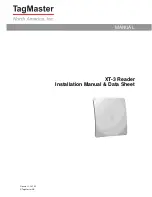
EliteIQ
TM
User Manual
51
9M02-7100-A001-EN
Version B
8
Glossary
Item
Description
Access Code
A four-digit code that is entered to prevent any unauthorized personnel from
entering the Programming Mode.
Note:
When entering Programming Mode, either locally or remotely, the
access code must be entered.
Accumulated Time
The Digital Input card can be used to accumulate, or add up, all the time that the
input signal has been in the On, or Non-Normal, state. The accumulator adds all
the seconds for each time the signal goes into the On state. You program the limit
for this condition using the Duration Limit under the Channel Configuration
for the
specific channel being monitored.
Time is reported and displayed as Days Hours:Minutes:Seconds.
Accumulated time is reported as Days, Hours, Minutes and Seconds.
Acknowledge Alarms
Locally:
Press the ACK key on the keypad while the EliteIQ is in RUN mode.
Acknowledge Input
Channel
A digital input channel can be used to acknowledge alarms. When this channel
goes into the Non-Normal condition, it will acknowledge all active alarms.
AK
Shown on the display and in reports. Indicates the channel is in alarm and has
been acknowledged.
AL
Shown on the display and in reports. Indicates the channel is in alarm.
Alarm Code
The EliteIQ uses alarm codes on the display, status reports and alphanumeric
pager alarms to indicate the condition of an alarm or input, as follows:
OP – open on a digital input
CL – closed on a digital input
CM – communication alarm on a Modbus input/output
OL – open-loop condition on an analog input
TL – totalizer limit alarm on a digital input
DL – duration limit alarm on a digital input
LO – low limit alarm on an analog input
HI – high limit alarm on an analog input
-R – negative rate of change alarm on an analog input
+R – positive rate of change alarm on an analog input
Alarm Delay
The amount of consecutive seconds an input needs to exceed a Limit before it
goes into alarm.
[0-65535 seconds] (default is 3 seconds).
Channel LED blinks green during this time.
















































